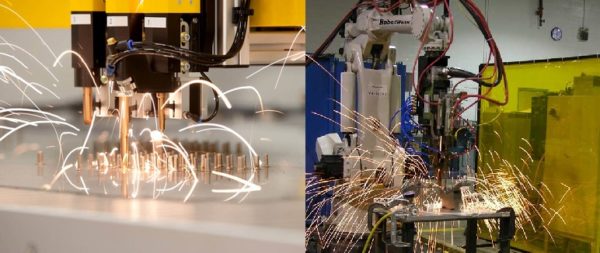Stud welding and spot welding are two welding processes industries can use to attach fasteners to metal materials. Though both processes can achieve this, differences between the two methods can lead to very different applications and results. Read on to discover the differences between stud welding vs spot welding.
What is Spot Welding?
Spot Welding is a form of resistance welding also known as Resistance Spot Welding (RSW). Spot Welding involves using heat produced by resistance to an electrical current to join materials together. The current heats the materials to a point where they become malleable. The use of strong pressure bonds them together.
Another form of resistance welding is Projection Welding. This process involves fusing a fasteners embossed or coined projections to the metal base material to form a weld. As the materials never melt, they do not intermix. This means the resulting weld is more like a forging of the materials.
Spot welding is only suitable for a small selection of base materials. Low carbon steel is the most suitable material for spot welding. This is because it is more resistant to electricity and has a lower thermal conductivity than the copper electrodes used to create the required electrical current.
High carbon steels and aluminium alloys can form brittle welds that dont last with the spot welding process. Pure aluminium can qualify for spot welding but requires higher current levels. This is because it has a lower resistance to electricity than low carbon steel.
What is Stud Welding?
Stud welding involves creating an electric arc between the fastener and parent material. The heat melts the two together and fuses them using return pressure. There are three main types of stud welding, all of which produce powerful welds but involve slightly different methods of welding the stud to the parent material:
Capacitor Discharge Stud Welding
Capacitors with a pre-set voltage discharge their stored energy as a high current pulse. This produces an arc and melting the stud pip, which is touching the base materials surface. Return pressure pushes the stud onto the base, giving complete fusion across the flange. Suitable for materials of 0.7mm and above thickness.
Drawn Arc Stud Welding
The stud itself is placed onto the material. A calculated current and weld time is triggered to create a pilot arc as the stud lifts to a pre-set height. The end of the stud and parent metal melt, and the stud is returned into the molten pool onto the plate. A ceramic ferrule contains and shapes the molten metal. Suitable parent material thickness is one-third of the stud diameter.
Short Cycle Stud Welding
This form of stud welding using Capacitor Discharge style studs. However, it is more tolerant of uneven and dirty surfaces than the CD stud welding process. This process uses the arc welding approach but removes the need for ceramic ferrules and reduces the cost of weld studs being used. Welding with shielding gas produces the best results. This process is suitable on a minimum parent material thickness of 1.5mm.
Stud welding is an intensely powerful and effective method of fusing fasteners to metal surfaces. This is particularly true when you use an automated system, which maximises efficiency while providing superior accuracy. Depending on the applications required, stud welding suits a range of material types and thicknesses, including steels, brass, copper, aluminium and aluminium alloys, and a variety of finishes.
Stud Welding vs Spot Welding

Unlike spot welding, stud welding does not require high-pressure equipment; neither does it require access to both sides of the work to be effective. These factors make stud welding a more flexible and economical choice for a range of welding operations, whereas spot welding requires higher production volumes to be financially feasible.
The stud welding process is also more versatile in the use of materials; you can stud weld carbon steels and aluminium alloys in the appropriate conditions and using the correct process. The same is not true for spot welding. When your operations and the materials you use happen to suit spot welding this can be a great process, but stud welding is suitable for a much wider range of applications.
Got a question about stud welding and how it compares to other methods of attaching fasteners to metals? Get in touch with us and a Taylor Studwelding expert will be happy to answer your questions!

